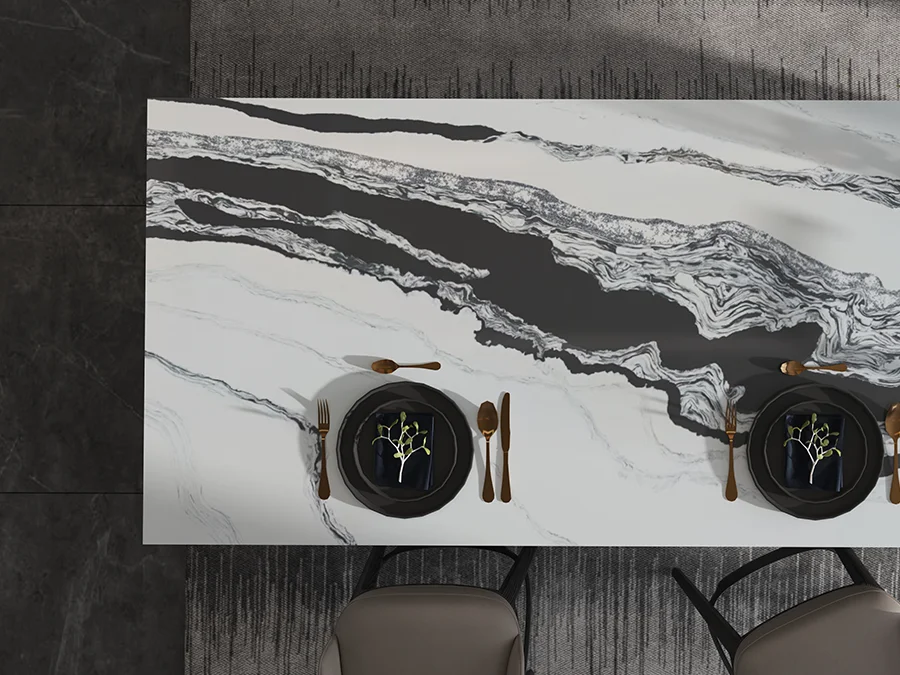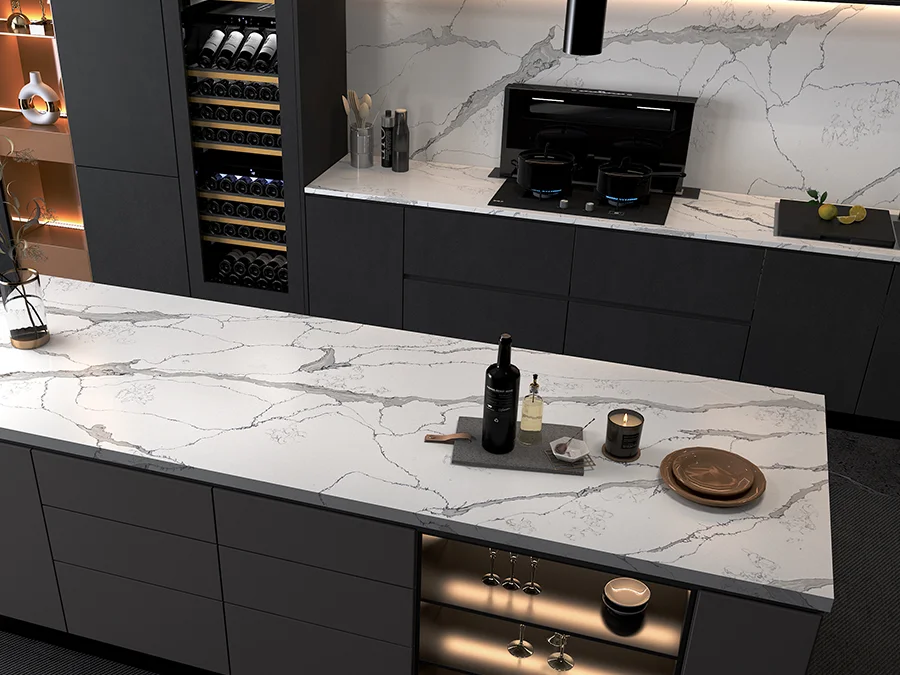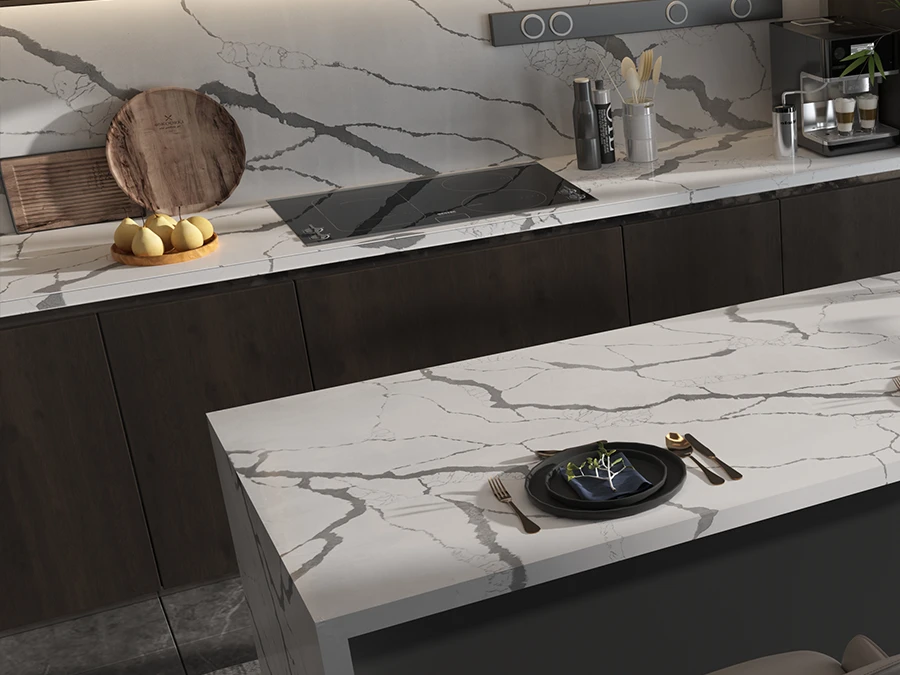
With the widespread use of quartz countertops, the issue of surface contamination has received a lot of attention. This article provides you with professional and comprehensive analysis and answers.
Table of Contents
Types and Causes of Quartz Countertop Contamination
Oil Stains
The main sources of contamination include paint and cooking oil. During kitchen installation, if surface protection is not properly done, paint contamination is likely to occur. When you are working in the kitchen, cooking oil is also hard to avoid, and may drip or splatter onto the countertop. These oil stains will form stubborn substances on the surface.
Metal Stains
Rust stains are the most common. The causes are as follows: during installation, your countertop may come into contact with iron materials or tools, and after friction, iron residues remain on the quartz surface, which then oxidize into rust; if the countertop comes into contact with iron cookware and has water underneath, and you do not move it, it creates the condition for rust oxidation. Rust stains are also the most troublesome issue for many people.
Colored Liquid Contamination
Common examples include coffee, tea, and red wine. When drinking these dark liquids, if they come into contact with the countertop, and the quartz stone you purchased has poor porosity, the pigment components are more likely to seep into the sealing layer or resin of the countertop, leading to deep stains.
Water Stains
They usually appear as white or yellow-brown powdery residues that are hard to remove. Although quartz countertops have high hardness and stain resistance, when they come into contact with hard water containing minerals like calcium and magnesium, they may still leave water stains on the surface.
Ink Stains
When ink stays on the quartz countertop for a long time, most of it will stay on the surface, and a small amount may seep into the sealing layer, causing it to be impossible to wipe off.
Bacterial Contamination
Areas of the countertop close to water are more likely to experience this problem. In addition to damp environments, the attachment of organic matter and surface stains will provide nutrients for bacteria to grow, and over time, bacterial contamination can occur.

Solutions and Tools for Various Contaminations
Oil Stains Cleaning
According to a common practice, cleaning methods can be classified into daily cleaning, medium cleaning, and deep cleaning depending on the obstinacy of the stain.
• Clean Daily: Wiping with neutral dishwashing liquid or soapy water is possible. To create a cleaning solution, mix dishwashing liquid and warm water; next, take a damp cloth or sponge to wipe the countertop, rinse off with clean water, and finally dry off with a dry cloth.
Essential Tools: When cleaning with a neutral dishwashing liquid, soapy water, damp cloth, sponge, dry cloth.
• Medium Cleaning: For hard oil stains, prepare 1/2 cup baking soda or white vinegar mixed with water, wipe, rinse with clean water and dry.
Tools Needed: Baking soda, white vinegar, damp cloth, sponge, dry cloth.
• Deep Cleaning: If both fail then, paste for removing oil is useful. Heat-stained area with hot air blower 50-60°C, evenly apply the oil-removal paste. Scrape it off with a spatula after it dries and forms a white powder.
Tools you need: Air blower, spatula, oil removal paste.
Metal Stains Cleaning
As an example, cleaning methods for rust stains can generally be classified, by the effectiveness and gentleness of the cleaning, as follows:
Toothpaste Cleaning Method: You need to apply the toothpaste evenly on the rusty area on the countertop, for about 10 minutes, the surface will be wiped clean with a damp cloth. This method is the easiest to perform and least damaging to the quartz surface.
White vinegar: Pour some white vinegar onto the rusty surface and leave it there for 10 minutes, wipe it with a dry cloth, then rinse and dry. White vinegar is very acidic and can slightly damage the countertop.
Use the vitamin C tablet method:Crush the tablet, mix it with some water to form a paste and then, spread it on the affected area and let it sit for 10minutes then rinse it with water and wipe it dry. This method utilizes the vitamin C oxidizing effect.
Rust Remover Technique: Buy a rust remover and follow directions.
84 — Disinfectant Method: Apply to the rust and let sit for 10 minutes before wiping with a dry cloth and rinsing with water and drying. Use gloves and a mask, because 84 disinfectant is corrosive.
Hydrochloric acid: soak for 5 minutes, then wash and dry. This method is the least recommended because hydrochloric acid is highly corrosive and needs more precaution.
Dark Liquid Contamination Cleaning
Cleaning methods are classified as daily cleaning, persistent stains cleaning, and deep cleaning:
• Daily cleaning: The optimal solution is to clean as soon as possible. At this stage, the dark liquid pools on top of the quartz countertop surface, and is a breeze to wipe away. If there are remaining stains after cleaning, you could use a mild cleaning agent such as a neutral dishwashing liquid or a stone cleaner mixed with warm water, and wipe with a soft cloth.
Essential Tools: Mild dishwashing liquid, stone cleanser, soft cloth
• Cleaning Out Stubborn Stains: Combine an equal weight of baking soda with water to create a paste, leave it on the stain for 15 minutes and then wipe off.
You will need: Baking soda, soft cloth, dry cloth
• Deep Cleaning: We advise using professional quartz cleaners, wipe with a soft cloth. Among them are stone cleaning powder, stone discoloration cleaners, stain-removing polishers and others, to local conditions.
What You’ll Need: Commercial quartz cleaner, soft cloth.
Water Stains Cleaning
Cleaning methods can be divided into two: daily cleaning and medium cleaning:
Daily Cleaning: In case of simple water stains, simply wipe immediately with a damp cloth and then dry with a dry cloth.
What You Need: A damp cloth, a dry cloth.
• Medium Clean: Combine white vinegar and baking soda, spray on water stains; wait for them to dissolve and wipe clean.
Tools Required: White vinegar, baking soda, damp cloth and dry cloth.
Ink Stains Cleaning
Cleaning methods are categorized according to how hard the “stuff” is to get off:
• Damp Cloth Wiping – this is the most basic step and also works for the majority of on spot cleaning cases
• Eraser Method — for removal of marks on surface.
· Solving Laundry Powder: Mix in a ratio of 1:0.5 with water, forming a paste, then apply, then leave for 5 minutes, then scrub it with a soft brush, then rinse and dry.
• Alcohol or White Vinegar: If the ink stains are difficult to remove, you can use alcohol or white vinegar.
• Professional Cleaner: We recommend reaching out to a local pro if none of the methods mentioned work.
Bacterial Contamination Cleaning
Follow these steps:
• Eliminate Surface stains — a soft cloth gently wipes down the countertop
• Cleaning Solution Prep: Mild cleaner e.g. dishwashing liquid
• Gentle Scrub: Use a soft-bristled brush to scrub gently in circular motion.
• Rinse and Dry: Wipe with a wet towel, dry with a dry towel.
Featured Tools: Multiple fluffy towels, neutral detergent dish soap, soft bristle brush.

Dos and Don’ts
In addition to cleaning your quartz countertop, you should also be mindful about how to protect it. Here are some dos and don’ts:
Dos:
• Use mild cleaning agents
• Clean stains promptly
• Keep the countertop dry
• Use heat-resistant mats
• Regularly wax the surface
• Chop foods on a cutting board rather than directly on the surface
Don’ts:
• Do not use steel wool or hard brushes
• No use of the concentrated chemical
• Do not apply direct heat
• Do not place the countertop in direct sunlight
• Do not use bleach
• Do not put countertop into abuse

Quartz Countertop Maintenance Tips
Besides cleaning, you also have to maintain it in the long run to make sure that your quartz countertop does not fall prey to those contamination issues in the above list because it would eventually waste your time and money.
- Keep olive oil and other condiments, especially dark-hued ones, stored in easily negotiable spots such as a small cart or spice rack to create less direct contact and prolonged countertop exposure that can lead to hard-to-remove stains.
- Switch to food-grade stainless steel products instead of iron goods that could pose a risk to metal contamination.
- Use high-quality under-mount sinks for kitchen sinks that will help to keep the surrounding free from dirt and bacteria.
- Get into the habit of wiping down surfaces as soon as you’re done with them. It takes just a few seconds and could save you a headache down the line. Also, in case the kitchen is unused, clean the place regularly, dust settles down there as well.

Secrets to Keeping Your New Countertop Looking New in 2025
If you’re getting new quartz countertops in 2025, these secrets will keep it looking brand new:
• Choose high-quality quartz: The primary step is choosing an aesthetically appealing, high-quality quartz countertop. The worst contaminants are related to poor quartz quality — specifically, the absorption rate. Brand matters, and do test to check quality before you buy
• Opt for a Professional Countertop Team: The expertise of the installation team matters because their skills impact the final quality of your countertop. Because only a professional team knows how to properly handle the backboards, edges, seams, and sealing. Be sure the countertop has protective film placed over it for installation and use.
• Countertop Use: Quartz is hard and heat-resistant but handle it with care to minimize knife marks and stains.
• Cleaning: Clean stains immediately: It decreases the time for pigments to settle in the surface.
• Maintenance: After performing the above steps, maintaining your quartz countertop will be a breezy task. Have a pro come in to periodically maintain and polish it, so the surface remains shiny and new.

Conclusion
Cleaning quartz countertops must start by determining the source of the stain, and its extent, chosen the right solution and by the daily usage to ease future maintenance.
FAQs
How do I restore the shine to my quartz countertop?
Aside from regular cleaning and precautions, you may rely on local professionals for help. They utilize polishing paste and water polishing pads to polish your countertops.
How to clean without streaking?
Three key points to ensure a streak-free natural clean.
• Use a mild, neutral cleaner.
• Clean with soft cleaning tools such as sponges.
• Do not let liquids soak and clean up immediately
Do you have any specific cleaning tips for bathroom quartz countertops?
The bathroom is the most humid area in the home, so we recommend good ventilation and a clean, dry space. This will keep bacteria from growing and make it easier to clean.
How do the cleaning differences between white and black quartz countertops?
White quartz countertops are more prone to details that get dirty and require more frequent cleaning. Black countertops are less prone to stains and a little easier to care for.
What are the best ways to protect quartz countertops?
You can opt to keep it so and apply a clear protective film over it that will resist heat and stains.
